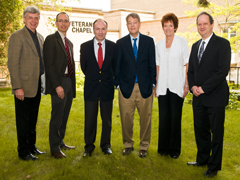At the heart of the summit
By Eleni Kanavas
Sunnybrook Research Institute (SRI) hosted the fourth annual Canadian CTO Summit on June 10, 2011. Researchers, clinicians and industry partners from around the world gathered in Sunnybrook's Harrison Hall for a research day devoted to chronic total occlusions (CTOs).
Chronic total occlusions are blocked coronary arteries that affect an estimated 20% of patients with coronary artery disease and more than 50% of patients with peripheral (limb) arterial disease. Studies have shown that revascularization, a surgical procedure that restores blood supply to an organ, of coronary CTOs can significantly improve angina and left ventricular function.
The conference, Translating Science to the Clinic, focused on the benefits of revascularization, tissue characterization of preclinical and clinical CTOs, and new imaging modalities and treatment strategies for CTOs.
Dr. Graham Wright, an imaging scientist and director of the Schulich Heart Research Program at SRI, moderated the workshop. The symposium featured keynote speakers Dr. Gerald Werner from Klinikum Darmstadt in Germany and Dr. Patrick Whitlow from the Cleveland Clinic in the U.S.
"In the past few years, we've summarized work on characterizing models of this disease that we've developed," Wright said in his opening remarks. "Today we look forward to a lot of collaborative discussion on new ideas, as well as how far we've come, what we've learned and where we're going based on what we've learned."
Wright is also a professor at the University of Toronto and co-lead investigator of the Canadian Institutes of Health Research (CIHR) team in occlusive vascular disease. He holds the Canada Research Chair in Imaging for Cardiovascular Therapeutics.
During a session on new treatments and imaging strategies, Dr. Bradley Strauss, chief of the Schulich Heart Centre at Sunnybrook, presented results from a "first-in-patient" trial he led using an enzyme called collagenase to soften coronary occlusions in patients. Strauss, who is also a senior scientist at SRI and co-principal investigator of the CIHR team, and his lab developed collagenase 10 years ago. Results since then have shown steady progress. He presented preclinical findings at earlier CTO summits that showed using collagenase to break down the arterial blockage significantly increased guide wire crossing rates.
"Dr. Strauss has been working on CTOs for a very long time, and I think we're seeing major advances from his career investment in this field," Wright said.
Twenty male patients participated in the study, which was a collaboration between Sunnybrook and St. Michael's Hospital. During the procedure, Strauss used a microcatheter to inject the collagenase into the CTO to soften plaque buildup in the artery and allow for stenting the next day.
Strauss and his team had an 80% success rate, crossing and stenting 16 of the 20 patients in the study without damaging any of the normal layers of the blood vessels during angioplasty. All patients had a follow-up three-month coronary computed tomography angiogram, as mandated by Health Canada. The exam showed that the artery remained open for those who had a successful crossing.
"Many of these cases still remain very challenging; I think CTO angioplasty remains the most challenging of any part of angioplasty that's being done," Strauss said in his presentation. "They are not done in two minutes even with this type of therapy, but nevertheless, some cases are easier than others."
The CIHR team grant is in its last year of funding. Wright said they will work on ways to keep it going next year.



